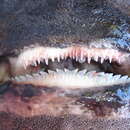Diagnostic Description
provided by Fishbase
Dark brown or blackish in color, dorsal fins with fairly prominent fin spines, moderately long snout, lanceolate upper teeth and bladelike lower teeth with short, oblique cusps, stocky body that tapers abruptly from pectoral region, and moderately large tricuspidate and tricarinate lateral trunk denticles (Ref. 247).
- Recorder
- Cristina V. Garilao
Life Cycle
provided by Fishbase
Ovoviviparous (Ref. 26346). Distinct pairing with embrace (Ref. 205).
- Recorder
- Cristina V. Garilao
Morphology
provided by Fishbase
Dorsal spines (total): 2; Analspines: 0; Analsoft rays: 0
- Recorder
- Cristina V. Garilao
Trophic Strategy
provided by Fishbase
Found on continental and insular slopes. Occurs in large schools near the bottom which are segregated according to size and sex. Feeds on cephalopods and bony fishes.
- Recorder
- Drina Sta. Iglesia
Biology
provided by Fishbase
A rare species inhabiting lower continental slopes (Ref. 26346), also on insular slopes in large schools near the bottom which are segregated according to size and sex, and feeds on cephalopods and bony fishes (Ref. 247). Up to 36 young in a litter, ths size at birth between 32 and 36 cm (Ref. 247). Used for fishmeal and liver oil (Ref. 6871). Minimum depth from Ref. 247. Ovoviviparous (Ref. 205).
- Recorder
- Kent E. Carpenter
Importance
provided by Fishbase
fisheries: of no interest
- Recorder
- Kent E. Carpenter

